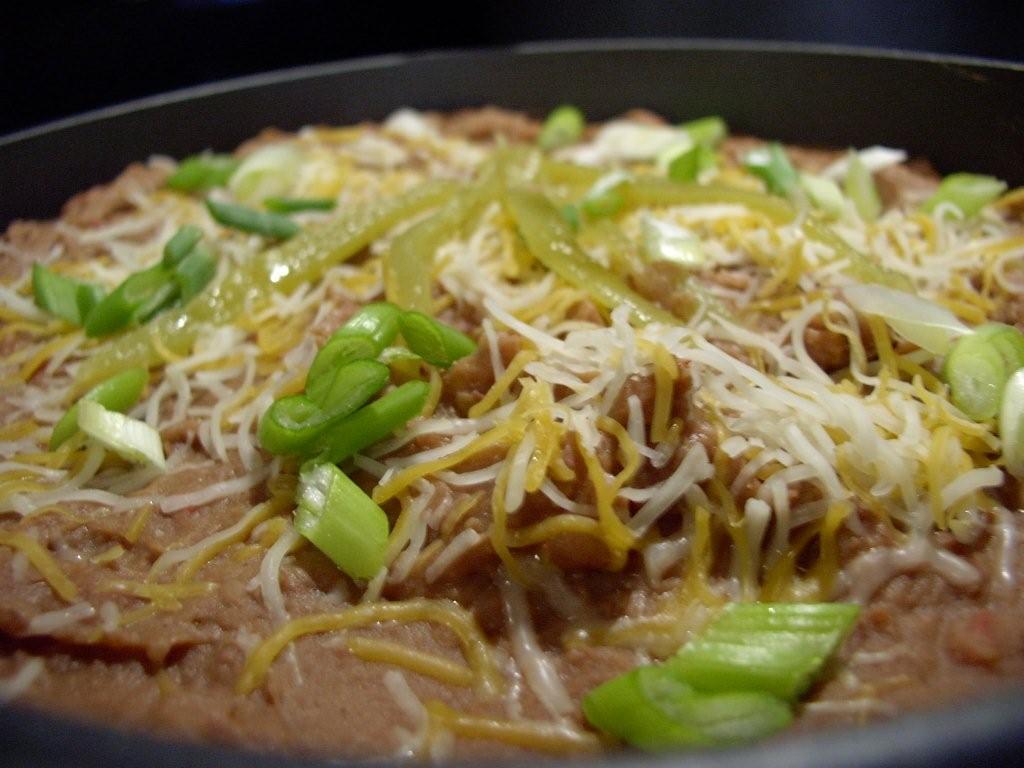
Refried Beans

|
Refried Beans
Refritos |
|
The frijol, the pinto bean, has been a dietary staple of Latin America since antiquity. Refried beans are called that because they are cooked twice. First in water once to make the beans tender, mashed and then recooked, or refried, in fat to prepare the for serving. They are not fried twice as the name might imply. Refritos and corn tortillas has been the dietary mainstay that has sustained the Mexican people and allowed them to build a long and exalted history. I have stayed with a large Mexican family and was able to watch and learn of the place of refritos in their daily life. A twenty quart pot on the stove was a permanent fixture. For each new batch of beans, a kilogram of pinto beans, some salt and water to cover was added to the pot. The beans were heated to a boil, the heat reduced and the beans simmered until they were tender. Water was added at intervals to keep them from going dry and burning. The cooked beans were removed from the heat and mashed with a good, old-fashioned potato masher. The first time I watched, I asked if they ever ate beans whole, like in chili and beans. It was a blank stare in response to my question. "No," they said, "beans are always cooked this way, boiled, mashed and then refried." Refried beans have a long tradition. The pot with the mashed beans stayed on the stove covered with a cloth. It was a large family in a small house and there was really no room for them to all sit down together for a meal. Maybe that is why most of the family members ate when they felt like it. When hungry, the person would heat some lard in a small frying pan. They would then add a few large spoonfuls of the mashed beans and fry and stir them until heated through. While they were refrying the beans, tortillas were heated over another burner of the stove and wrapped in a towel to keep them warm. After the beans had been heated and plated, bits of the tortillas were torn off to make scoops for the beans. The tortilla was the bread of the meal and the eating utensil as well. Is it worth making your own refried beans? If you are asking that question, then it is obvious that you have never eaten anything but canned refried beans. If you like refried beans and have never tasted freshly made refritos, than I would suggest that you make one batch just to see. I believe you will be more than pleased with the results. If you use a small can of refried beans once in a blue moon, then this recipe will be more of a curiosity value. If you use a lot of refried beans, then this version may be of immediate interest for your next batch of beans. If, like me, you use a can of refried beans every couple of weeks, then you are sort of in the middle. I have home-canned refried beans but find it is easier to freeze the unused portion for later. Large mouth Mason jars work just fine because there is no narrow neck and the beans will thaw overnight in the refrigerator an slide out of the nicely the next day. Mexican families traditionally refry their beans in lard. This improves the texture as well as giving added flavor to the beans. I use bacon fat. I crisp fry the bacon and crumble it into the beans. I use some of the rendered bacon fat to refry the beans. In the Mexican family, the beans were refried in batches as needed. I refry all the beans so all I have to do later is heat and eat. |
|
Preparation Time : About 2 hours Makes about 4 quarts |
Life Experience Recipe
|
Ingredients:
|
|
| Procedures:
Crisp fry bacon, cool and crumble. Set aside. Reserve rendered drippings. Packaged dry beans sometimes come with added pebbles and twigs. Sort, cull and inspect your beans. Discard any questionable beans. Rinse in colander. Place beans in pot. Add chicken broth and add enough water to cover the beans. Heat to boiling, reduce heat and simmer, stirring frequently. Add salt, pepper and chili powder. Add water as need during cooking to keep the beans just covered with water. Canned beans are hard and solid. These beans, when mashed, should be softer. Cook until tender. Remove from heat. Allow to cool to handling temperature. Stir in crumbled bacon bits. In batches, with potato masher or stand mixer, mash beans. I like a little texture in my beans so I don't process until thoroughly mashed. I leave some bits of beans to go with the bits of bacon. In hot frying pan, add enough reserved bacon drippings to lightly cover bottom of pan. Add spoonfuls of mashed beans fill pan. Stir and fry. You don't want to cook until a crust forms but almost. Repeat until all beans are refried. Most often the refried beans are serve as a side dish. I like to garnish the hot beans with a sprinkle of Mexican-style four-cheese blend or grated Monterey jack cheese, some sliced scallions and a bit of finely diced tomatoes. |

|